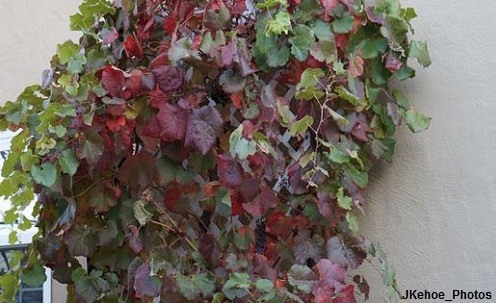Graybark Grape
(Vitis flexuosa)

Description
Vitis cinerea, the graybark grape, is a variety of grape. It has small black berries that are mildly unpleasant to eat. Plentiful in Missouri and Louisiana, it is also found throughout the eastern half of the US as far west as Texas, north to Illinois, and south to Florida. It is also known by the name winter grape or possum grape. Vitis cinerea is an American native grape. The leaves are cordiform-emarinate, flabby, dull, limb finely wrinkled (like crepe) between the sub-veins. The teeth of the leaf are very blunt. The buds are grey-ashy-violet. Vitis (grapevines) is a genus of 79 accepted species of vining plants in the flowering plant family Vitaceae. The genus is made up of species predominantly from the Northern Hemisphere. It is economically important as the source of grapes, both for direct consumption of the fruit and for fermentation to produce wine. The study and cultivation of grapevines is called viticulture. Most cultivated Vitis varieties are wind-pollinated with hermaphroditic flowers containing both male and female reproductive structures, while wild species are dieceous. These flowers are grouped in bunches called inflorescences. In many species, such as Vitis vinifera, each successfully pollinated flower becomes a grape berry with the inflorescence turning into a cluster of grapes. While the flowers of the grapevines are usually very small, the berries are often large and brightly colored with sweet flavors that attract birds and other animals to disperse the seeds contained within the berries. Grapevines usually only produce fruit on shoots that came from buds that were developed during the previous growing season. In viticulture, this is one of the principles behind pruning the previous year's growth (or "One year old wood") that includes shoots that have turned hard and woody during the winter (after harvest in commercial viticulture). These vines will be pruned either into a cane which will support 8 to 15 buds or to a smaller spur which holds 2 to 3 buds. Flower buds are formed late in the growing season and overwinter for blooming in spring of the next year. They produce leaf-opposed cymes. Vitis is distinguished from other genera of Vitaceae by having petals which remain joined at the tip and detach from the base to fall together as a calyptra or 'cap'. The flowers are mostly bisexual, pentamerous, with a hypogynous disk.
Taxonomic tree:







